Greetings to all the friends of SteemitCryptoAcademy!
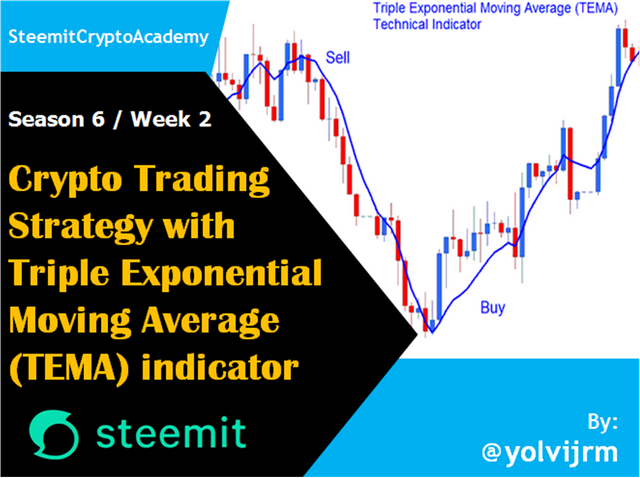
It is a pleasure for me to present my homework for professor @fredquantum, where he is talking about the Crypto Trading Strategy with Triple Exponential Moving Average. It was a class with a lot of learning, for which I want to thank the teacher.
I will now answer the questions raised by the teacher.

1.- What is your understanding of Triple Exponential Moving Average (TEMA)?
Moving averages are generally considered to be one of the simplest indicators, very useful for both beginners and advanced traders in the trading set. These types of moving averages include simple moving averages, exponential moving averages, and weighted moving averages.
In this case we will be dealing mainly with the Triple Exponential Moving Average, which is a type of technical indicator in the moving average branch that works as an advanced type of moving average, eliminating the aspect of delays and noise created by the other types of moving averages. moving averages.
In normal moving averages, they generally have the appearance of a lot of noise and are lagging indicators that tend to give signals very late when the trend should have started and advanced a bit when compared to other leading indicators such as the stochastic indicator. So, in general, the triple moving average solves this behavior.
The Triple Exponential Moving Average, which was developed by the famous Patrick Mulloy, was first used in stock trading and later adopted in cryptocurrency trading. Actually, he considers three Exponential Moving Averages for his calculation and subtracts the lag.
In this sense, it should be noted that the Triple Moving Average has the following characteristics:
It can be used to recognize clear trends and trend changes.
It can be used in the identification of support and resistance zones.
The Triple Exponential Moving Average (TEMA) can be used in the identification of buy and sell zones, by means of the crosses under two TEMA indicators of different periods.

2.- How is TEMA calculated? Add TEMA to the crypto chart and explain its settings. (Screenshots required).
Three exponential moving averages are going to be used to calculate the Triple Exponential Moving Average, which will result in noise and delays being removed as the calculation is performed below:
TEMA = [3 * EMA1 - 3 * EMA2 + EMA3]
In which, EMA1 is the exponential moving average
EMA3 is the exponential moving average of EMA1
EMA3 is the exponential moving average of EMA2
In the formula described, 3 is the coefficient of the exponential moving average, 1 and 2 are the product of the respective EMA. Also, we have all the EMAs using the same period for their calculation.
To add TEMA, the Tradingview.com will be used; in which it will be started by logging in and the indicator interface will be selected.
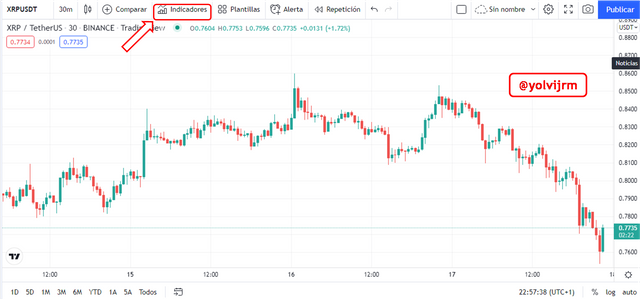
After selecting the search bar, we type Triple and then select Triple EMA as shown below:
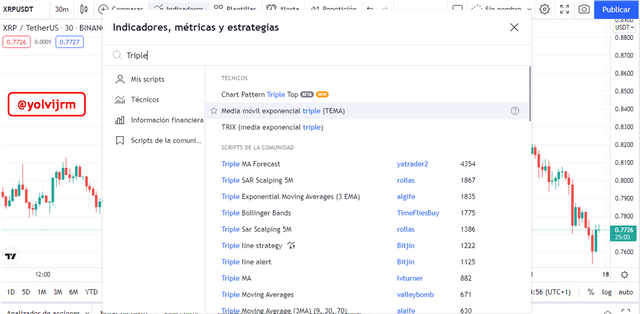
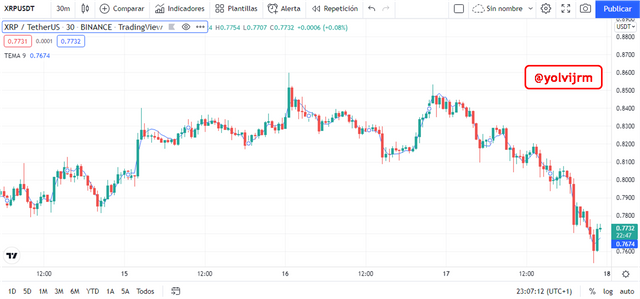
To configure it, select the configuration option in the indicator and change the default length from 9 to 25 and configure the style so that it is to my liking.
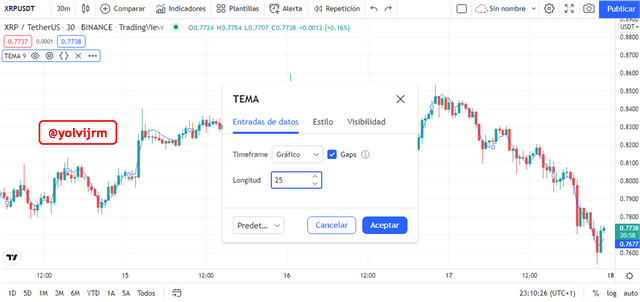
In general, the higher the period number, the easier it is to see the changes made to the prices. Changing the period to 25 will give a clearer indication of price changes.

3.- Compare TEMA with other Moving Averages. You can use one or two Moving Averages for in-depth comparison with TEMA.
3.1.- TEMA and SMA
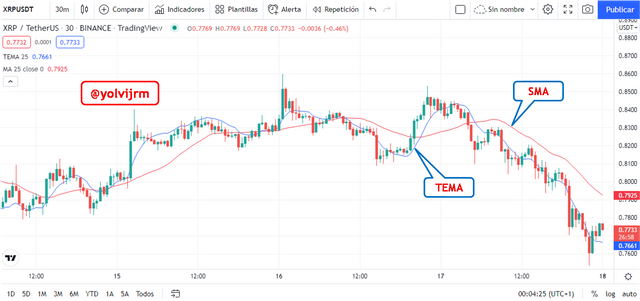
Starting with the calculations between the TEMA and the simple moving averages, it can be seen that the simple moving average takes into consideration the average data of a specific period. Relating this to the TEMA indicator will have some complex calculations involved.
Also, looking at the noise aspect, it is known that the simple moving average produces some noise in its movement, while the TEMA indicator has less noise.
Most of the moving averages are lagging indicators, the simple moving average turns out to be one of the lagging indicators, while the calculations in the TEMA indicator remove that aspect, making it easier to spot signals.
3.2.- TEMA and EMA
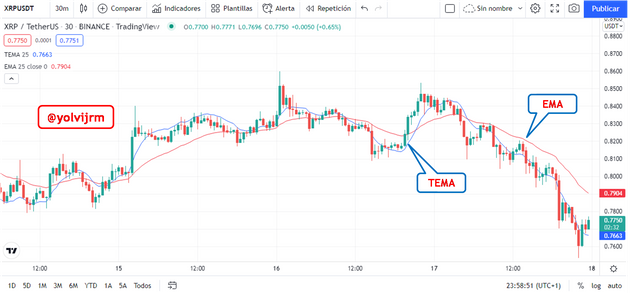
When making the comparison of the TEMA indicator and the exponential moving average, they are all trend based indicators that are used in the location of trends as well as the entry and exit points of funds at crossovers when used 2 at a time with a higher and lower period.
Coming to the efficiency aspect, TEMA is known to be more efficient than exponential moving average as it removes noise and delay from its emitted signal.
Similarly, we know that EMA serves as a dynamic support in an uptrend, while the TEMA indicator acts as a dynamic resistance in an uptrend.

4.- Explain the Trend Identification/Confirmation in both bearish and bullish trends with TEMA (Use separate charts). Explain Support & Resistance with TEMA (On separate charts). (Screenshots required).
4.1.- Identification and confirmation of trends using TEMA
Bullish Trend
The TEMA is an indicator that is based on trends and can be used to find the trend of an asset. The bullish trend is observed when you have the prices and the angles of the TEMA indicator in an upward direction.
For further confirmation after identification, the price of that asset will need to trade above the TEMA indicator. In the chart below, you can visualize on the XRP/USDT 15min time frame how prices are trending above the TEMA indicator.
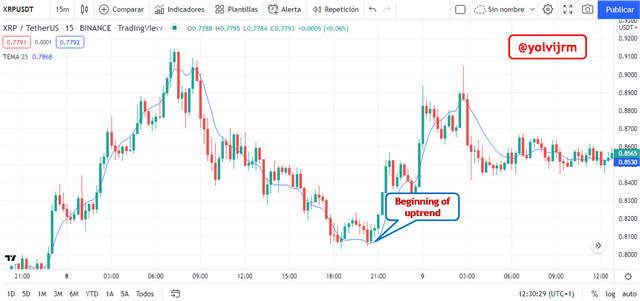
Bearish Trend
As noted, TEMA is a trend based indicator and can also be used to find the downtrend of an asset. The bearish trend can be observed by having the prices and the angles of the TEMA indicator in a downward direction.
For further confirmation, after identification, the price of that asset will trade below the TEMA indicator. In the chart below you can see on the XRP/USDT 15-minute time frame, as prices are trending below the TEMA indicator.
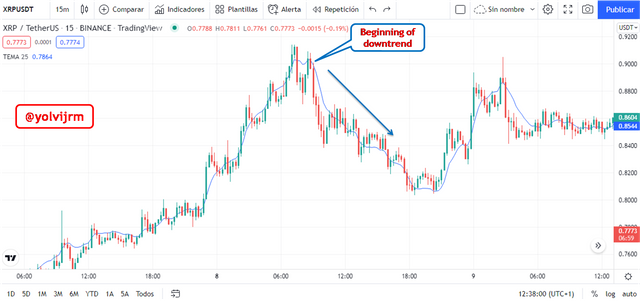
4.2.- Support and Resistance with the TEMA Indicator.
Dynamic Support
The TEMA indicator can be used as a dynamic support level and, when correctly identified with other confirmations, can serve as a suitable entry. The dynamic support level indicates a trend change from a downtrend to an uptrend.
The dynamic support level is seen in a downtrend showing prices bouncing off that level. In this sense, this opportunity can also be used in a buy entry with other signal confirmations.
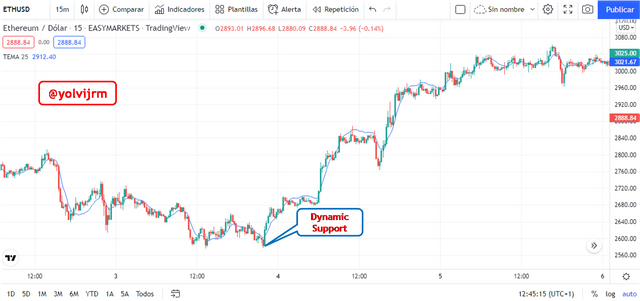
Dynamic Resistance
The TEMA indicator can also be used as a dynamic resistance level and, when correctly identified with other confirmations, can serve as a suitable entry. The dynamic resistance level indicates a trend change from an uptrend to a downtrend.
The dynamic resistance level is seen in an uptrend showing prices bouncing off that level. In this sense, this opportunity can be used in a sell entry with other signal confirmations and proper risk management.
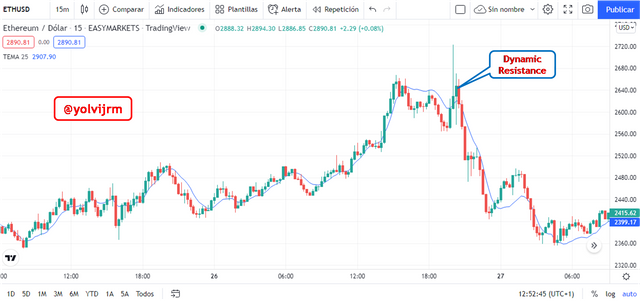

5.- Explain the combination of two TEMAs at different periods and several signals that can be extracted from it. Note: Use another period combination other than the one used in the lecture, explain your choice of the period. (Screenshots required).
A relevant issue of the TEMA indicators is that you can take advantage of their different periods and use their crosses to find entry and exit positions in the market. This selection criterion is based on choosing one with a longer term and another with a shorter term. In this sense, the crossings will be made as the TEMA of the lower period crosses the TEMA of the higher period, thus generating signals.
The TEMA of 20 and 40 periods will be selected. Normally, period 20 will be the shortest, which will be the fast moving TEMA, and period 40 will be the slow moving TEMA, which will make its crossovers generating various signals. Also, it is noted that the choice of periods is a range for short-term traders, as extending to 100 and 200 will take more time to generate signals, which is particularly useful for long-term traders.
Using the ETH/USDT chart above, you start by identifying the current trend, which should be a downtrend avoiding sideways moves. The end of the downtrend is seen when we have the 20 TEMA cross above the 40 TEMA. This shows a trend change from a downtrend to an uptrend and a buy order can be placed.
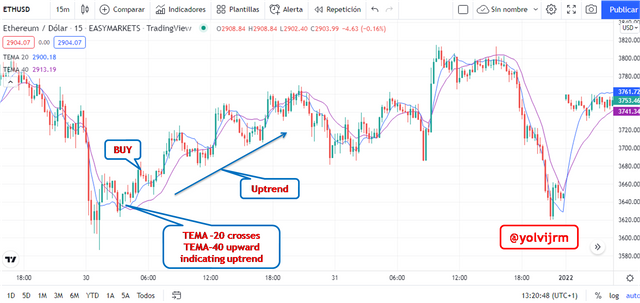
Using the ETH/USDT chart shown above, it starts with identifying the current trend, which should be an uptrend avoiding sideways movement. The end of the uptrend is seen when we have the 20 TEMA cross below the 40 TEMA. This shows a trend change from an uptrend to a downtrend and a sell order can be placed.
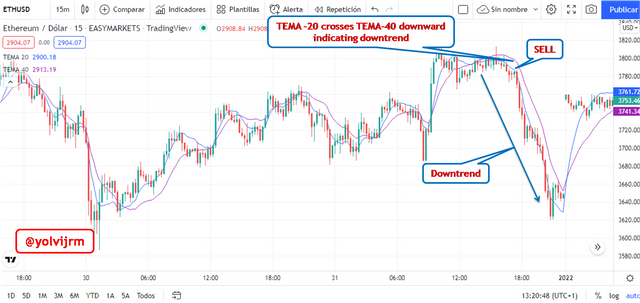

6.- What are the Trade Entry and Exit criteria using TEMA? Explain with Charts. (Screenshots required).
#####6.1.- Trade entry and exit for a buy order
To carry out the commercial demonstration, the two TEMA indicators will be used, which are the 20 and the 40 TEMA, which were previously explained. With that selection, the following procedures below will be followed;
- It will start by adding TEMA 20 and 40 to the table.
- As you are looking for a buy entry, it is preferable that the current trend is a downtrend that is identified with prices below the indicators.
- Then a buy order will be entered after the 20 TEMA crosses above the 40 TEMA with at least 2 candlestick formations.
- The trade exit is to set a stop loss below the crossover or preferably below the last swing low and take profit at a risk to reward ratio of 1:1 to 1:2.
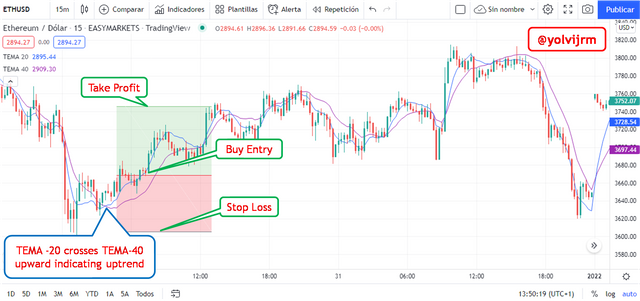
6.2.- Trade entry and exit for a sell order
To perform the trading demo, the two TEMA indicators will be used, which are the 20 and 40 TEMA, as stated above. With that selection, the following procedures below will be followed;
- It will start by adding TEMA 20 and 40 to the table.
- Since you are looking for a sell entry, it is preferable that the current trend is an uptrend that is identified by prices above the indicators.
- A sell order is then entered after the 20 TEMA crosses below the 40 TEMA with at least 2 candlestick formations.
- The exit of the trade is to set a stop loss above the crossover or preferably above the high point of the last swing and take profit at a risk to reward ratio of 1:1 to 1:2.
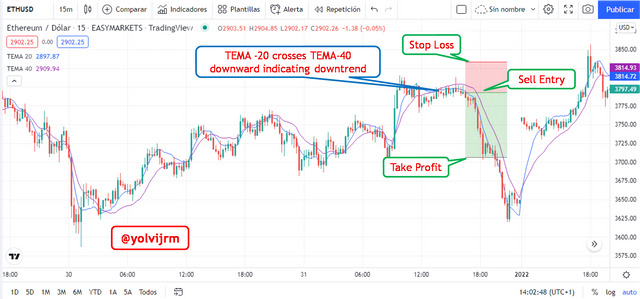

7.- Use an indicator of choice in addition with crossovers between two TEMAs to place at least one demo trade and a real margin trade on an exchange (as little as $1 would do). Ideally, buy and sell positions (Apply proper trade management). Use only 5 - 15 mins time frame. (Screenshots required).
Actual Sell Order Trade XRP/USDT
We will start by adding TEMA 20 and 40 to the table. Since you are looking for a sell entry, it is recommended that the current trend is an uptrend that is identified by prices above the indicators.
Then a sell order is entered after the 20 TEMA crosses below the 40 TEMA with at least 2 candlestick formations.
The trade exit is to set a stop loss above the crossover or preferably above the high point of the last swing and take profit at a risk to reward ratio of 1:1 to 1:2.
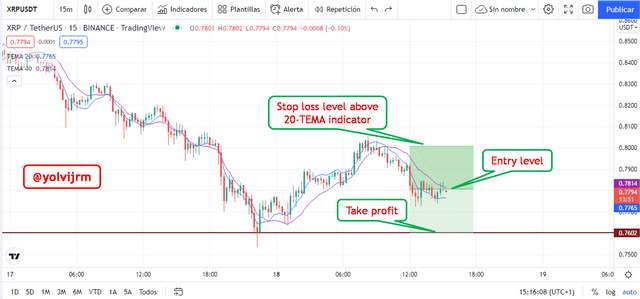
For further confirmation, the Simple Moving Average with a period of 25 will be used. When prices drop below the MA, it is an indication of a downtrend as seen.
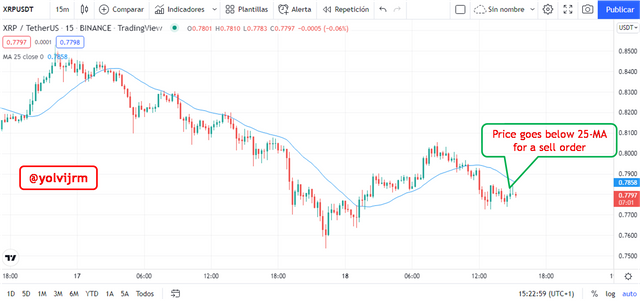
The trade placement will be made with Binance Exchange using an initial margin of $24usdt
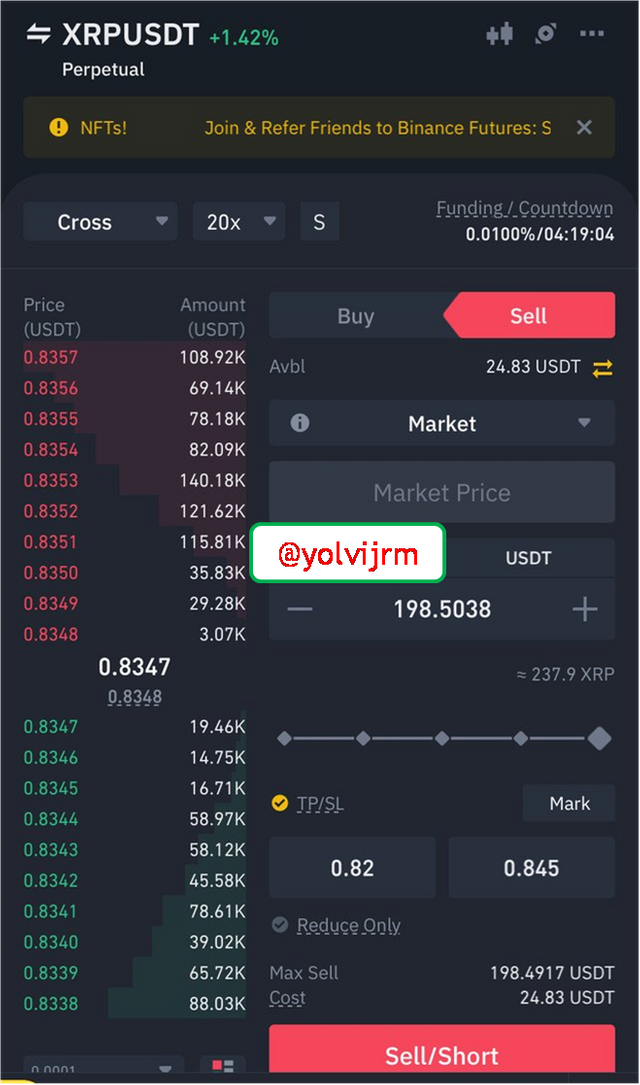
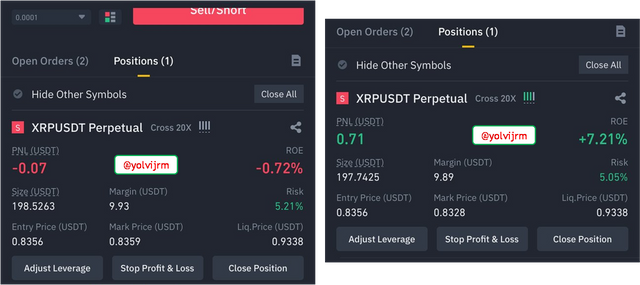
Demo buy trading with LTC/USDT
It will start by adding TEMA 20 and 40 to the table. Since you are looking for a buy entry, it is preferable that the current trend is a downtrend that is identified by prices below the indicators.
A buy order is then entered after the 20 TEMA crosses above the 40 TEMA with at least 2 candlestick formations.
The trade exit is to set a stop loss below the crossover or preferably below the last swing low and take profit at a risk to reward ratio of 1:1 to 1:2.
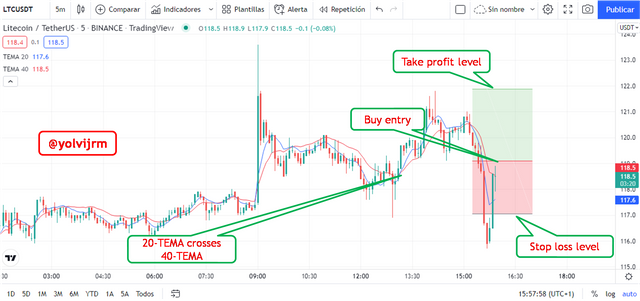
Further confirmation is made using the Simple Moving Average with a period of 25. As prices break above the indicator, it shows a buy entry.
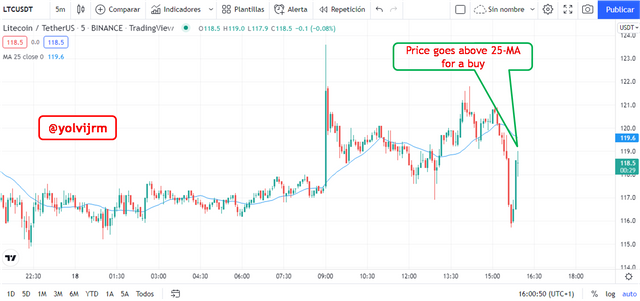
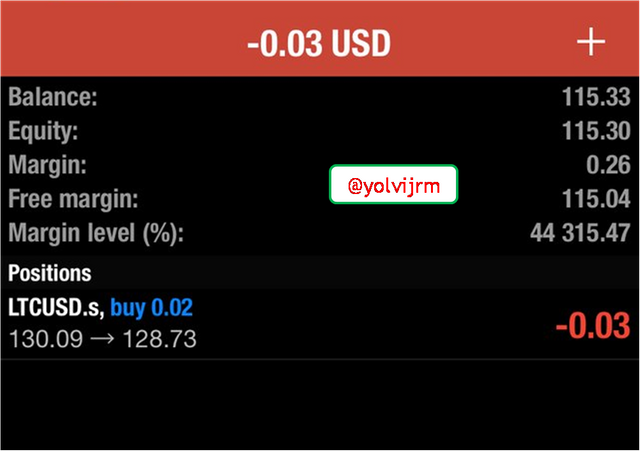

8.- What are the advantages and disadvantages of TEMA?
The Triple Exponential Moving Average (TEMA) indicator offers several advantages and disadvantages, which will be indicated below:
Advantages
The TEMA indicator is related to faster price changes than other types of moving averages, resulting in lag reduction based on its calculation. This ensures early capitalization of trading opportunities.
The TEMA represents price changes very similar to other moving averages, where trends are identified by the angle of the indicator line up or down, making it relatively easy to use and understand.
The TEMA also identifies dynamic support and resistance levels following the further development of the price movement. This helps traders identify entry and exit points when trading.
The TEMA indicates buy and sell opportunities with its crossover strategy, where two TEMAs with different timeframes are combined to generate a trading signal.
Disadvantages
The TEMA indicator is only useful in trending market conditions. In the absence of a trending market structure, TEMA often generates distorted trading signals.
The reduced lag of the TEMA indicator in some cases leads to an unclear signal as the indicator reacts quickly to price movement, making it less reliable in volatile market conditions.
The TEMA indicator's dynamic resistance and support level can be easily traded due to how it reacts to price. For example, taking a sell position after a break below the TEMA line serves as dynamic resistance, then the next candle closes above the TEMA line.

Conclusion
The Triple Exponential Moving Average (TEMA) indicator works by applying a smoothing function generated from its calculation, which ensures that the indicator ignores lags and random price fluctuation, generating a smoothed representation of the indicator data relative to the price movement.
The TEMA indicator represents trend directions using the angled slope of its oscillating line. TEMA also identifies dynamic support and resistance levels following the further development of the price movement. This helps traders identify entry and exit points when trading.
